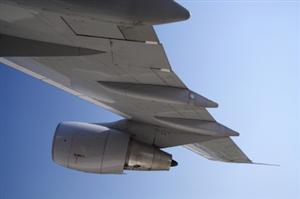| Complexity level: | 9 |
| Project cost ($): | 20 |
| Time required: | It will take an hour to set up the experiment, and an hour to conduct it |
| Material availability: | Easily found |
| Safety concerns: | Basic safety requirements |
Hypothesis
Bernoulli’s principle operates the best with objects that are in the shape of an airfoil.
Overview
Bernoulli’s principle
Bernoulli’s principle states that the pressure exerted by a fluid will reduce when the speed of the fluid increases.
Take two pipes of different diameters that are joined together with a pipe connector. Let's say the fluid enters through the pipe with the larger circumference and exits through the pipe with the smaller circumference. Because the same volume of fluid entering the pipe is the same as that exiting the pipe, the fluid will have to travel more quickly through the small pipe. In other words, as the fluid enters from the larger pipe to the smaller pipe, the pressure of the fluid will increase. This added pressure will cause the fluid to travel more quickly within the small pipe and as the fluid travels more quickly, the pressure of the fluid will drop.
Aerofoil shapes apply Bernoulli’s principle to produce lift in airplanes. The airfoil shape (see figure 1) will cause the air to travel more quickly along the top surface and more slowly along the bottom surface. Therefore the air pressure on the top side of the airfoil is lower than at the bottom. This will produce an upward lift on the airfoil, and as a result, the airplane will climb.
Scientific Terms
Materials
The materials required for this science experiment are as follows:
- a fan
- 3 treads that are each about 400mm long
- 3 sheets of light but stiff cardboard
- a roll of scotch tape
- a ruler
Procedure
1. For this science project, the independent variable is the shape of the objects used in this experiment. The dependent variable is the amount of air lifton the object. This can be ascertained by measuring the heights to which the objects are lifted, using a ruler. The constants (control variables) are the wind speed, the depth or width of the objects and the weight of the objects.

2. Cut 3 strips of cardboard to approximately 50mm x 150mm. Bend these strips to form the 3 shapes shown in figure 1 above. Use a roll of scotch tape to stick the 2 ends of the strips together.
3. Measure the distance between the floor and the center of a fan.
4. Put a string through the gap in object 1 (an airfoil) and tie both ends to the fan’s front frames.
5. Switch on the fan and watch the airfoil float. Measure the length of the distance between the rear the object and the floor, and deduct this from the distance measured in procedure 3. Record the result in the table below.
6. Repeat procedures 4 and 5 with objects 2 and 3.
Note: The Bernoulli’s principle should cause the objects to float. However, the objects will also be dragged down by their weight. If a strip of cardboard is too thin or flexible, the wind will blow the cardboard out of shape. Use Experiment with strips of cardboard that have different thickness and weights in order to obtain the desired results.


Results
The strip in the shape of an airfoil was lifted the highest. Bernoulli’s principle operated the best in objects that were the shape of an airfoil.
|
Shapes of objects |
Fan center height (mm) |
Height of objects (mm) |
Float height (mm) |
|
Shape 1 - airfoil |
1100 |
1108 |
8 |
|
Shape 2 - symmetrical |
1100 |
1044 |
-56 |
|
Shape 3 – reverse airfoil |
1100 |
986 |
-114 |
The chart below represents our results

Conclusion
The hypothesis holds true - the strip in the shape of an airfoil was lifted the highest. Bernoulli’s principle operated the best in objects that were the shape of an airfoil.
Bernoulli’s principle and airfoil designs are used in to design aircraft and race cars. The airfoil of an aircraft’s body and wings are an essential to flight. As for race cars, the airfoil keeps the rear wheels of a car on the ground, by producing a downward pressure/force on the rear of the car.
Also consider
Alter the width of the shapes.
Use winds of different speeds.
References
Bernoulli’s principle - http://en.wikipedia.org/wiki/Bernoulli's_principle
Bernoulli’s principle - http://library.thinkquest.org/27948/bernoulli.html

